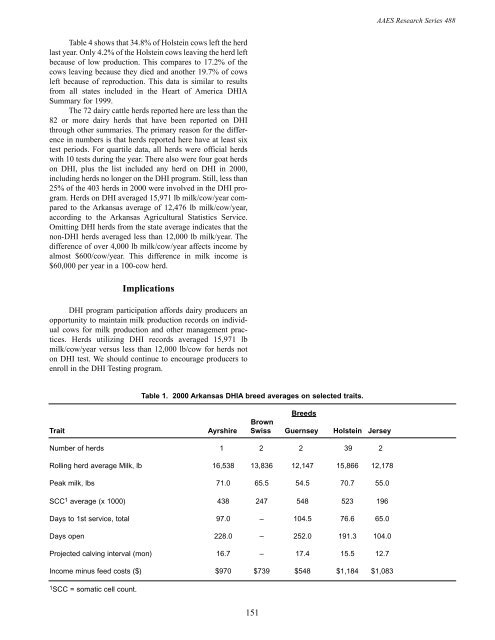Arkansas - Agricultural Communication Services - University of ...
Arkansas - Agricultural Communication Services - University of ...
Arkansas - Agricultural Communication Services - University of ...
You also want an ePaper? Increase the reach of your titles
YUMPU automatically turns print PDFs into web optimized ePapers that Google loves.
AAES Research Series 488<br />
Table 4 shows that 34.8% <strong>of</strong> Holstein cows left the herd<br />
last year. Only 4.2% <strong>of</strong> the Holstein cows leaving the herd left<br />
because <strong>of</strong> low production. This compares to 17.2% <strong>of</strong> the<br />
cows leaving because they died and another 19.7% <strong>of</strong> cows<br />
left because <strong>of</strong> reproduction. This data is similar to results<br />
from all states included in the Heart <strong>of</strong> America DHIA<br />
Summary for 1999.<br />
The 72 dairy cattle herds reported here are less than the<br />
82 or more dairy herds that have been reported on DHI<br />
through other summaries. The primary reason for the difference<br />
in numbers is that herds reported here have at least six<br />
test periods. For quartile data, all herds were <strong>of</strong>ficial herds<br />
with 10 tests during the year. There also were four goat herds<br />
on DHI, plus the list included any herd on DHI in 2000,<br />
including herds no longer on the DHI program. Still, less than<br />
25% <strong>of</strong> the 403 herds in 2000 were involved in the DHI program.<br />
Herds on DHI averaged 15,971 lb milk/cow/year compared<br />
to the <strong>Arkansas</strong> average <strong>of</strong> 12,476 lb milk/cow/year,<br />
according to the <strong>Arkansas</strong> <strong>Agricultural</strong> Statistics Service.<br />
Omitting DHI herds from the state average indicates that the<br />
non-DHI herds averaged less than 12,000 lb milk/year. The<br />
difference <strong>of</strong> over 4,000 lb milk/cow/year affects income by<br />
almost $600/cow/year. This difference in milk income is<br />
$60,000 per year in a 100-cow herd.<br />
Implications<br />
DHI program participation affords dairy producers an<br />
opportunity to maintain milk production records on individual<br />
cows for milk production and other management practices.<br />
Herds utilizing DHI records averaged 15,971 lb<br />
milk/cow/year versus less than 12,000 lb/cow for herds not<br />
on DHI test. We should continue to encourage producers to<br />
enroll in the DHI Testing program.<br />
Table 1. 2000 <strong>Arkansas</strong> DHIA breed averages on selected traits.<br />
Breeds<br />
Brown<br />
Trait Ayrshire Swiss Guernsey Holstein Jersey<br />
Number <strong>of</strong> herds 1 2 2 39 2<br />
Rolling herd average Milk, lb 16,538 13,836 12,147 15,866 12,178<br />
Peak milk, lbs 71.0 65.5 54.5 70.7 55.0<br />
SCC 1 average (x 1000) 438 247 548 523 196<br />
Days to 1st service, total 97.0 – 104.5 76.6 65.0<br />
Days open 228.0 – 252.0 191.3 104.0<br />
Projected calving interval (mon) 16.7 – 17.4 15.5 12.7<br />
Income minus feed costs ($) $970 $739 $548 $1,184 $1,083<br />
1 SCC = somatic cell count.<br />
151

















